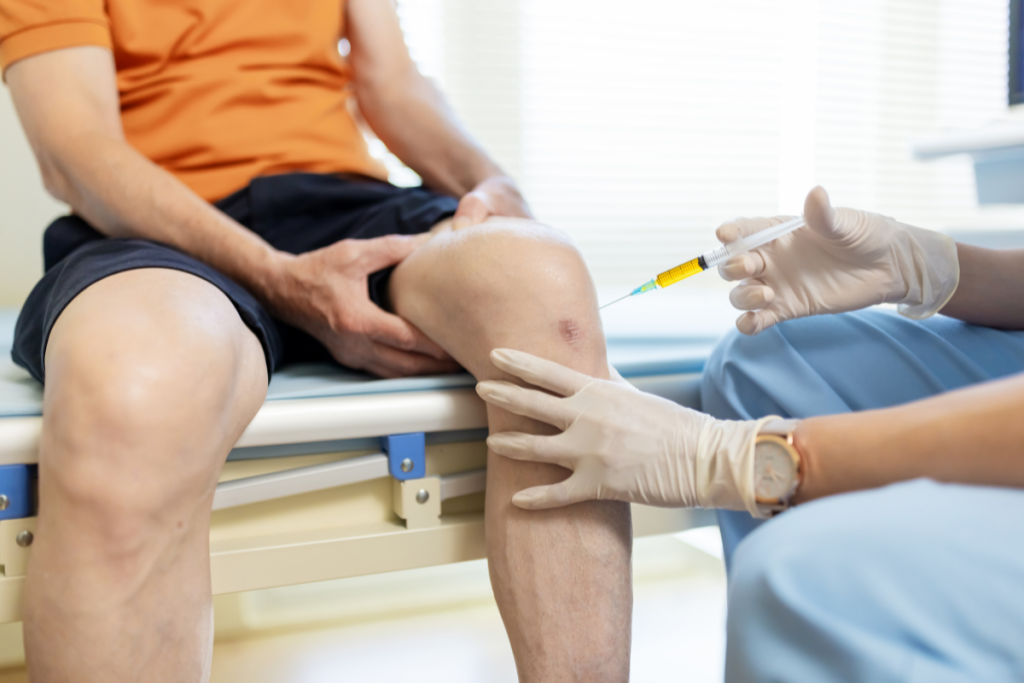Synvisc, a specialized gel-like substance, is injected into joints to alleviate pain and enhance mobility in individuals with joint conditions, notably osteoarthritis. Its primary purpose is to restore the lubricating properties of synovial fluid, the natural lubricant. It is important to note that joint requirements vary among patients, requiring tailored approaches for optimal results. That is why doctors focus on optimizing the timing and frequency of Synvisc injections.
This article explores the details of Synvisc treatment for optimal therapeutic results and helps readers understand the factors influencing personalized treatment strategies.
What is Synvisc?
Synvisc, short for sodium hyaluronate (hyaluronic acid), is a viscosupplement used in medical practice. It is a bioengineered, gel-like substance that closely mimics the synovial fluid found in healthy joints. This gel comprises hyaluronic acid, a naturally occurring component in joint tissues. The medication relieves discomfort and restores joint function, primarily in cases of osteoarthritis, but it may also have applications in other joint conditions.
The composition of this viscosupplement intrinsically governs its function. In osteoarthritis, synovial fluid can become thinner and less effective, contributing to pain and stiffness. This treatment aims to restore this balance, providing relief and enhancing mobility. When injected into the joint, they augment its natural synovial fluid, which acts as a lubricant and shock absorber, allowing for smooth, pain-free joint movement. The standard Synvisc dose is a series of three injections, typically given weekly.
Timing of Synvisc Treatment
Knowing when to get Synvisc is crucial for improving joint conditions, especially osteoarthritis. In this section, we explore the factors and recommendations for timing guidelines.
Factors influencing timing:
- Disease Progression: The progression of the underlying joint condition, such as osteoarthritis, influences the timing of Synvisc injections. When joint cartilage damage is minimal in the early stages, healthcare providers may consider this viscosupplement as a preventive measure. Doctors may adjust the doses to ease discomfort and improve joint function as the disease advances.
- Severity of Symptoms: The severity of joint symptoms, including pain, stiffness, and decreased mobility, is pivotal in deciding when to administer Synvisc. In cases where symptoms significantly affect the patient’s quality of life, healthcare providers may recommend early intervention to provide relief. Conversely, if symptoms are mild or intermittent, they may defer treatment until they become more pronounced.
- Patient’s Age and Activity Level: The patient’s age and physical activity level are important considerations. Younger or more active individuals may delay Synvisc treatment, opting for non-invasive methods initially. In contrast, older or less active patients may need early treatment intervention.
Benefits of early vs delayed injections:
The decision between early and delayed Synvisc shots carries specific advantages. Early injections help preserve joint function and slow disease progression, potentially delaying the need for more invasive treatments like joint replacement. However, delaying the treatment can allow patients to explore non-invasive alternatives first, making it a preferred choice for some.
Recommended timing guidelines:
While healthcare providers should tailor the schedule based on the patient’s needs, there are general guidelines for this treatment. Typically, healthcare providers consider Synvisc when conservative treatments like physical therapy, pain medications, and lifestyle modifications no longer provide adequate relief. They often advise patients to consider this viscosupplement when symptoms become severe and impair their ability to perform regular tasks.
Frequency of Synvisc Treatment
This section looks at the factors that influence how often you can receive these injections, considering factors like your type of arthritis, your body’s response system, and your doctor’s advice.
Factors influencing injection frequency:
- Type of Arthritis (e.g., Osteoarthritis): The type of arthritis significantly affects how often healthcare providers administer Synvisc. For instance, patients with osteoarthritis, a common form of degenerative joint disease, may require a different injection schedule than those with inflammatory conditions like rheumatoid arthritis.
- Patient’s Response to Previous Injections: The individual patient’s response to previous Synvisc shots also determines the frequency of subsequent treatments. Some patients experience long-lasting relief from a single treatment cycle, while others may require more frequent injections. Monitoring and assessing the patient’s response is crucial for tailoring the injection schedule to their needs.
- Physician Recommendations: Based on clinical assessment and experience, physician recommendations are a crucial factor influencing the treatment frequency. Healthcare providers often work closely with patients to establish a suitable injection plan. These recommendations are grounded in the patient’s overall health, joint condition, and treatment progress.
Number of injections in a treatment cycle:
Patients often need one injection every other week to ensure the joint gets enough hyaluronic acid to compensate for its deficiency in the body. However, healthcare providers can adjust this number based on a patient’s needs. Some may need fewer injections for relief, while others may need more.
Pros and cons of frequent vs. less frequent injections:
Frequent injections may offer more immediate and sustained relief, especially for those with severe symptoms. However, they can be associated with increased costs and a higher time commitment. Less frequent injections reduce the financial challenges but expand the time frame to achieve the desired results.
Efficacy and Clinical Trials of Synvisc
A culmination of multiple studies and clinical trials has underlined the effectiveness of viscosupplements in providing substantial relief and improving patient outcomes. Among these, Synvisc-One® (Hylan G‐F 20) stands out for its remarkable efficacy in managing pain associated with knee osteoarthritis. Consider the findings and results below:
Long-lasting and rapid pain relief
In controlled studies, Synvisc-One® consistently showed remarkable and sustained reductions in pain levels for up to six months compared to baseline measurements. What’s particularly noteworthy is its rapid onset of action, demonstrating noticeable pain reduction as early as one week following the initial injection. This enduring improvement was evaluated over 26 weeks, ensuring unbiased assessments by independent evaluators.
Superiority Over Placebo
The superiority of Synvisc-One® over placebo or saline control has been evident in pivotal clinical trials. Comparative analyses, while highlighting the Synvisc-One pros and cons, have consistently shown significantly greater improvement in knee osteoarthritis pain with SynviscOne compared to physiological control, underscoring its efficacy as an intervention, despite potential Synvisc side effects.
Comparative Analysis
One pivotal clinical trial, conducted across six European countries involving 253 patients, rigorously assessed Synvisc-One®’s safety and effectiveness for knee osteoarthritis. The study, employing a randomized, double-anonymized, 2-arm trial design, administered either Synvisc-One® or a saline control injection to patients.
The findings unequivocally favored Synvisc-One®, showcasing its superiority in reducing knee pain and enhancing patient outcomes over saline control. The trial carefully monitored adverse events throughout its duration.
Safety Profile
Although a small percentage of injections and patients reported adverse events, Synvisc-One® exhibited a favorable safety profile. Patients commonly reported pain, swelling, and joint effusion in the injected knee as device-related adverse events. Severe adverse events were notably absent in the Synvisc group.
Synvisc-One®’s consistent and substantial reduction in osteoarthritis knee pain, coupled with its rapid onset of relief and commendable safety profile, underscores its efficacy compared to placebos or saline control. These robust findings from clinical studies and trials reinforce its role as a valuable intervention in managing knee osteoarthritis, offering hope for improved pain management and enhanced quality of life for affected individuals.
Patient Experience with Synvisc
In this section, we delve into the real-world experiences and testimonials of individuals undergoing the innovative Synvisc treatment. Discover firsthand accounts below:
A physician’s appreciation of Synvisc:
Dr. Jennifer Madden, a physician, experienced osteoarthritis due to an old ACL injury. To relieve knee pain, she opted for Synvisc-One®, which significantly helped. This personal encounter with the condition enhanced her empathy and understanding for patients facing similar issues.
Dr. Madden emphasizes the importance of an active lifestyle despite knee pain, advocating tailored exercises like biking, Pilates, or dancing to boost mobility and maintain a healthy weight. She reinforces her patients’ advice by committing to staying active, aiming to find suitable long-term solutions, and ensuring that osteoarthritis knee pain doesn’t hinder their pursuits.
https://www.synviscone.com/what-is-synvisc-one/patient-stories/dr-jennifer-madden
How Mike restored his love for hunting:
Mike C, a 50-year-old resident of New Hampshire, encountered debilitating knee pain that interfered with his farm work and leisurely pursuits like hunting and fishing. Despite a diagnosis of mild knee osteoarthritis, the pain was severe, impacting his ability to carry out daily tasks. Traditional pain relievers offered minimal relief, prompting him to explore long-term solutions.
Upon his doctor’s suggestion, Mike opted for Synvisc-One® (hylan G-F 20), experiencing a significant reduction in his osteoarthritis knee pain. This treatment allowed him to return to activities he hadn’t enjoyed in years, such as hunting, inspiring him to share his positive experience. Mike reassures others that despite apprehensions about injections, the Synvisc-One injection was painless and offered prolonged relief, urging those hesitant about similar treatments to reconsider seeking help.
https://www.synviscone.com/what-is-synvisc-one/patient-stories/mike-c
Trudy K’s journey with a painless Synvisc injection:
Trudy K, a 55-year-old from New Jersey, grappled with osteoarthritis knee pain that disrupted her daily activities, making simple tasks like cooking dinner excruciating. The pain led to reduced mobility, weight gain, and a worsening cycle of discomfort. Despite a diagnosis of mild knee osteoarthritis, Trudy experienced intense pain that traditional remedies and steroid knee injections couldn’t alleviate.
Upon discovering Synvisc-One® (hylan G-F 20), she opted for the treatment and was pleasantly surprised by its simplicity—a quick, painless procedure. Gradually, the injections notably reduced her osteoarthritis knee pain, transforming her life. Trudy now emphasizes that accepting knee pain as an inevitable part of aging isn’t necessary—Synvisc-One offers a potential solution for those struggling with similar issues.
https://www.synviscone.com/what-is-synvisc-one/patient-stories/trudy-k
Optimizing Synvisc Treatment for Enhanced Joint Health
Optimizing Synvisc treatment for enhanced joint health involves a multifaceted approach centered on personalized care. Understanding the nuanced factors influencing the timing and frequency of injections is pivotal. Tailoring treatment based on disease progression, severity of symptoms, and individual patient characteristics ensures an optimal balance between early intervention to preserve joint function and reasonable use to maximize long-term benefits.
Synvisc has proven effective in managing conditions like osteoarthritis through tests and real-life stories. Customizing when and how often we administer injections to each person can enhance the effectiveness of the treatment. This approach tackles immediate pain and movement problems while promoting better long-term joint health. It’s like crafting a personalized plan that gives people more freedom in their daily lives, helping them move better and feel more comfortable.
What should I do after synvisc injection?
After a Synvisc injection for knee osteoarthritis, rest, apply ice, avoid heat/water, manage pain as directed, attend follow-ups, monitor for reactions, and be patient for relief, following the healthcare provider’s guidance closely.






